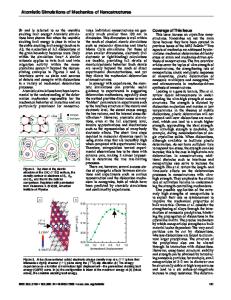Quantum atomistic simulations of silicon and germanium
- PDF / 218,211 Bytes
- 8 Pages / 612 x 792 pts (letter) Page_size
- 31 Downloads / 356 Views
Quantum atomistic simulations of crystalline silicon and germanium have been carried out by the path-integral Monte Carlo method. The interatomic interactions were modeled by Stillinger–Weber-type potentials, with parameters adequate to quantum simulations. Quantum zero-point motion together with anharmonicity of the interatomic potential led to a lattice expansion of 7 × 10−3 Å for both Si and Ge. Results for the equation-of-state (volume versus pressure) and for the thermal expansion coefficient agreed well with experimental results for both materials at T > 100 K and for hydrostatic pressures up to 100 kbar.
I. INTRODUCTION
Atomistic simulations of solids by molecular dynamics and Monte Carlo (MC) methods have been carried out for more than 20 years to study materials at a microscopic level and to derive macroscopic properties that could be compared with quantities measured in the laboratory. In classical simulations, atoms are treated as point particles that evolve in the configuration or phase space according to the laws of classical physics and subject to interatomic effective potentials developed to fit static and dynamical properties of the material under consideration. In this manner, several interatomic potentials were developed for diamond-type semiconductors, and different properties of these materials could be calculated from atomistic simulations.1–9 In recent years, mainly due to a continuous improvement in computational facilities, there has been a notable advance in the quantum simulations of materials. The seminal paper by Car and Parrinello in 1985 opened the way for materials simulations in which the interatomic interaction is obtained from first-principles calculations, without any fitting parameters.10 These kinds of simulations, although computationally more expensive than the classical ones, are now standard for theoretical studies of structural and dynamical properties of solids. This technique, however, treats the atomic nuclei as classical particles, neglecting typical quantum effects as zero-point motion or tunneling. Such quantum effects are relevant to understand thermodynamic and structural properties of solids at temperatures lower than the corresponding Debye temperature ⍜D. In condensed-matter physics and materials theory, these effects are usually taken into account by using harmonic or quasi-harmonic approximations. 11–14 The latter approximation is based on J. Mater. Res., Vol. 16, No. 9, Sep 2001
http://journals.cambridge.org
Downloaded: 16 Mar 2015
a renormalization of the phonon frequencies with volume, and for a given volume the solid is assumed to be harmonic.15,16 However, this approach is questionable when anharmonicities in the interatomic potentials are large. Important anharmonic effects are the thermal lattice expansion and the “zero-point lattice expansion”, the latter being due to zero-point atomic motion. Anharmonicity also causes an isotopic effect in the lattice constant of crystalline materials.17,18 A convenient theoretical tool to study these questions is t
Data Loading...







